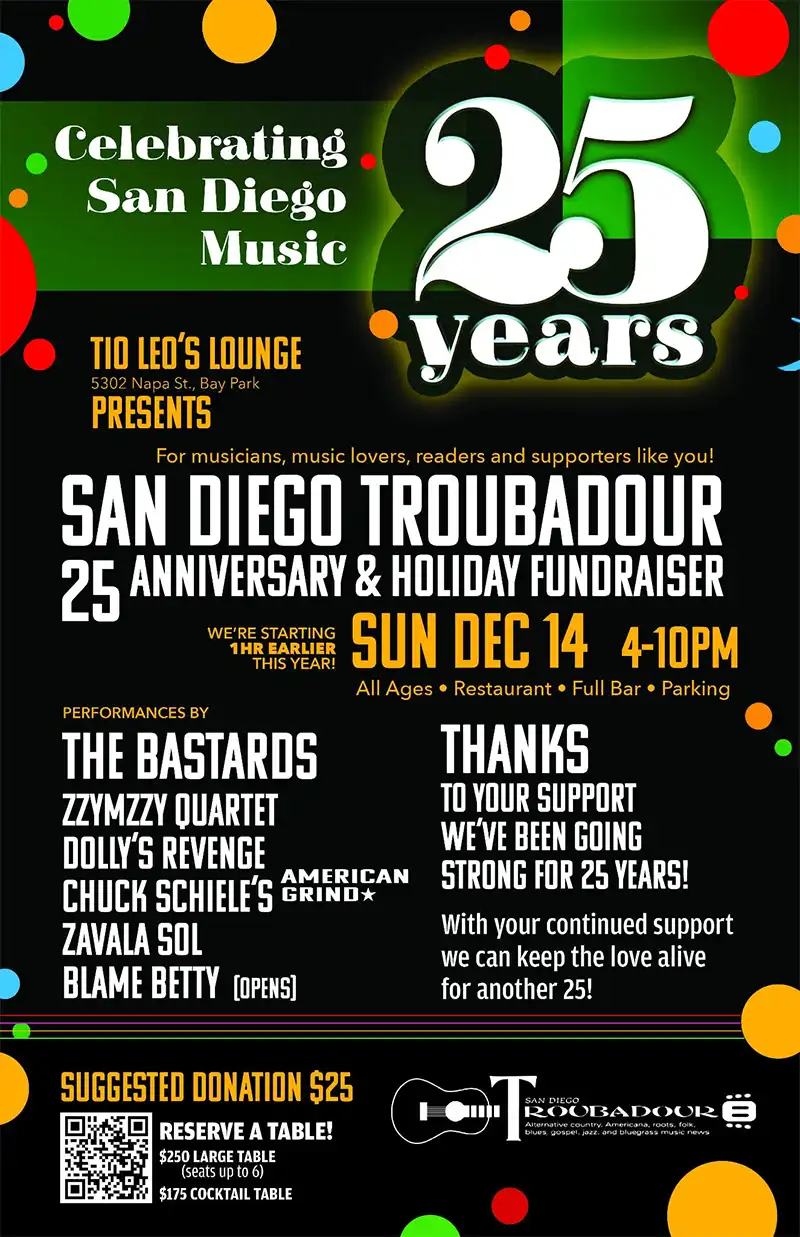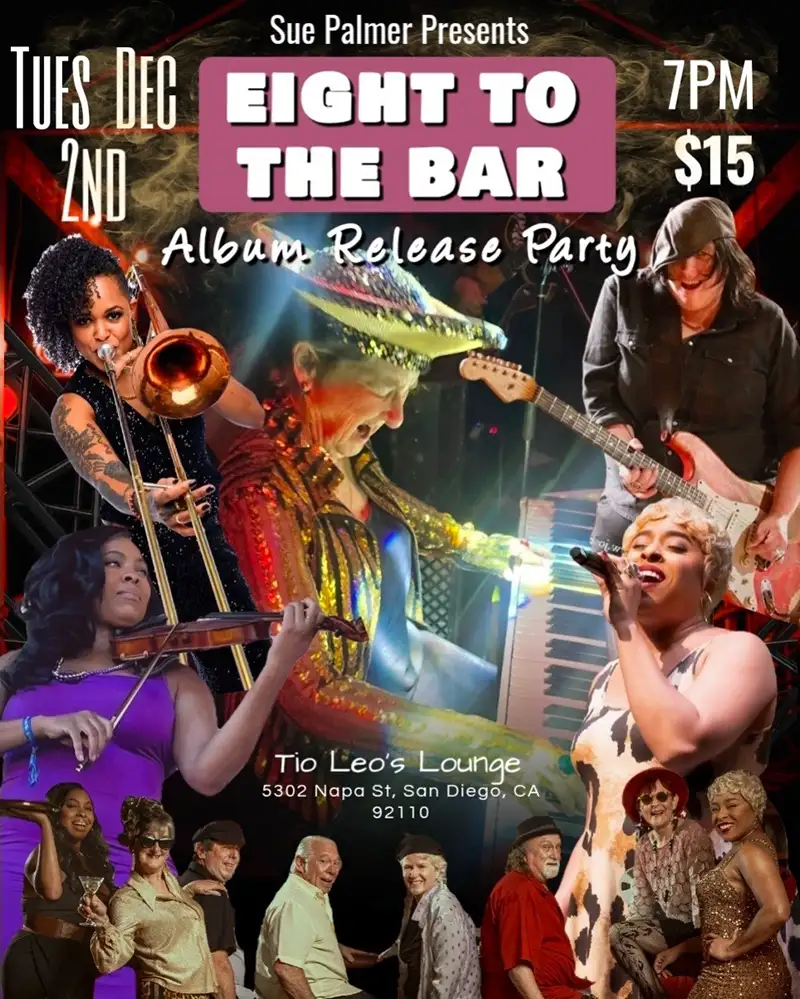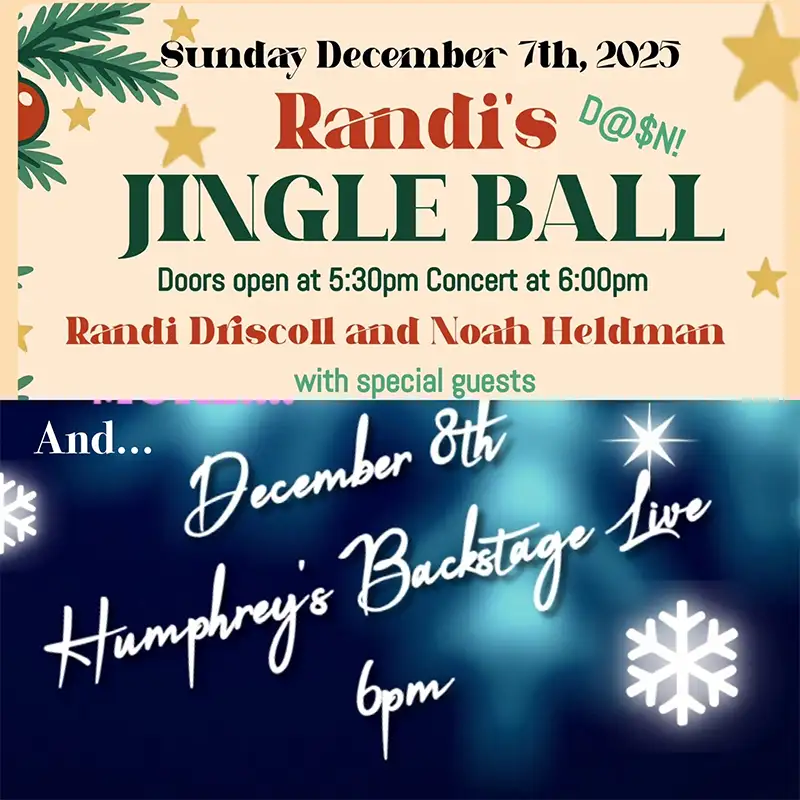Cover Story
Lori Bell: In her Own Words
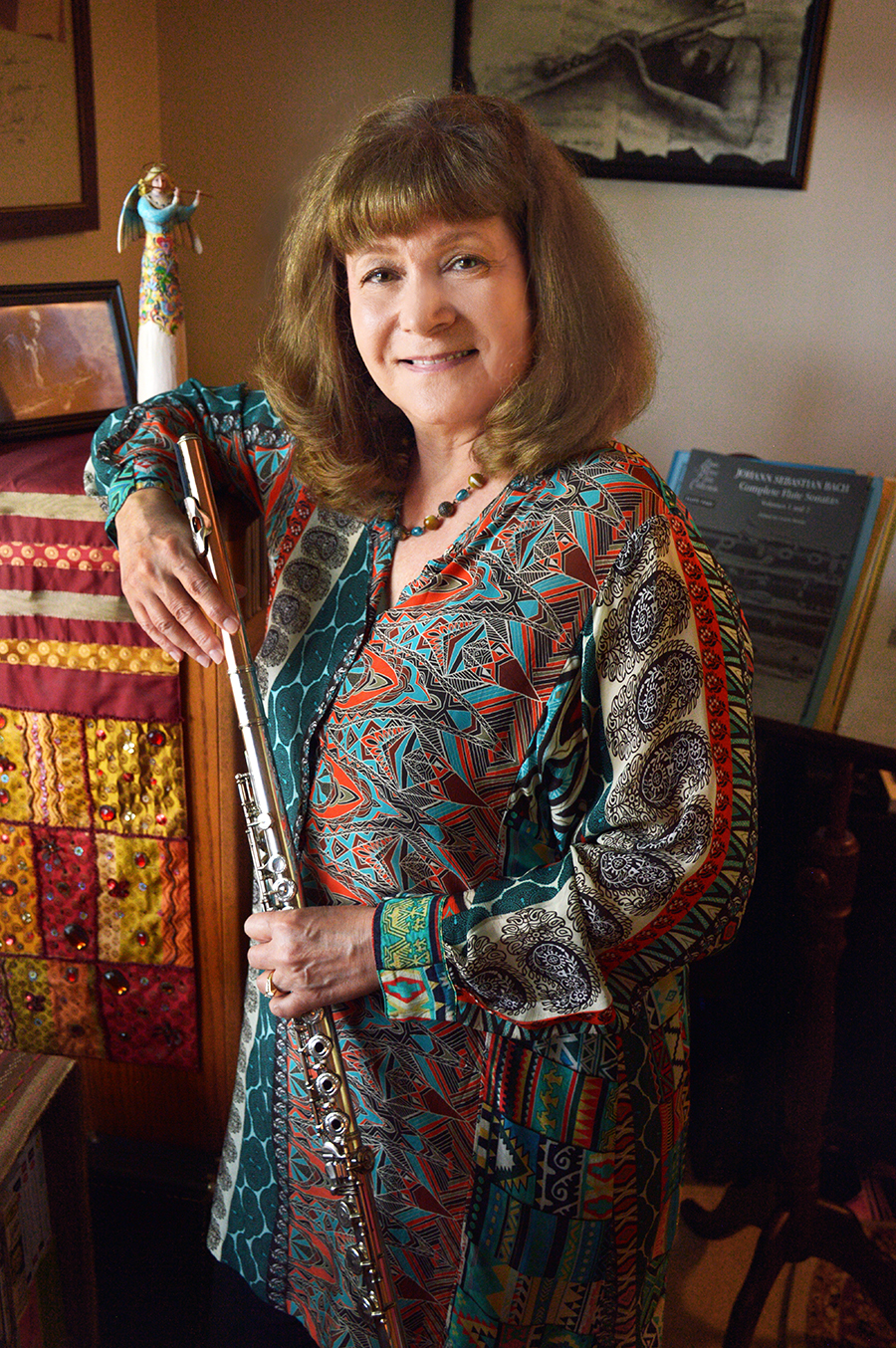
Lori Bell. Photo by MIchael Oletta.
Jazz flautist Lori Bell is constant wonder in the San Diego jazz scene and has been so for a good number of years. An East Coaster by birth, born in Brooklyn, who has brought a welcome New York energy to her West Coast performances. Busy, articulate, quick witted, at once delicate and in-your-face, Bell’s skills as an improvisor seem more like superpowers: natural and spontaneous. The consistent brilliance of her music makes that supposition seem like an idea worth considering. Bell, though, does what every master instrumentalist does to keep the music: working hard, keeping the music diverse, collaborating with a broad range of musicians, incorporating new ideas into her work, selecting the best material by notable composers for the richest results, and composing her own songs as well. Her dedication and discipline in putting her talents to work in the world has had widely acclaimed results.
Her 2016 album, Brooklyn Dreaming, is a jazz love letter to her life in the city of her birth and received a wave of accolades, winning a Global Music Award for Outstanding Achievement, garnering major kudos as Best Album of 2016 in Downbeat magazine, Best in Jazz 2016 in the Huffington Post, and a Best Jazz Album nomination from the San Diego Music Awards. She followed up in 2017 with the release of blues(s) with long-time musical partner, pianist, guitarist, and vocalist Ron Satterfield. It’s a breathless, gorgeous set of reinterpretations of classic jazz standards by Miles Davis, Bill Evans, and Thelonious Monk. Bell has kept herself busy with any number of projects to which she has added her singular virtuosity, including stints in a Los Angeles-based ensemble that pays tribute to the work of the late jazz reed player and composer Eric Dolphy at Mr. Music Head Gallery in Los Angeles.
Making her calendar even more crowded have been recordings and performances with San Diego based composer Joe Garrison’s ensemble the Night People, notably on the albums The People Under Upstairs and The Broken Jar. She performed double duty on these, producing both the albums as well as playing Garrison’s ingeniously arranged compositions.
The previous was a short list of her many and varied accomplishments. Lori Bell continues her adventures in making the jazz flute do unexpected and wonderful things with, as witnessed in last month’s concert with Trio de Janeiro (Ron Satterfield on guitar and vocals and Tommy Aros on percussion) playing “James Taylor Reimagined” at Leonard Patton’s Jazz Lounge and with the release of her breezily superb CD Recorda Me: Remembering Joe Henderson, reviewed in the Troubadour’s March issue of the Troubadour (https://sandiegotroubadour.com/lori-bell-quartet-recorda-me-remembering-joe-henderson/). The project is a loving and inspired investigation of the late saxophonist’s compositions. The reviewer summed up his estimation with “This music moves fast on the uptake, is light on its feet, and is memorable and compelling, rendered with a fervent wholeheartedness by a superlative ensemble.”
Reached by phone to talk about her new release, Joe Henderson, and the trio of musicians she worked with on it, the chat soon turns to how a Brooklyn girl who grew up in a house full of music wound up San Diego, establishing herself as a jazz flautist of seemingly boundless imagination.
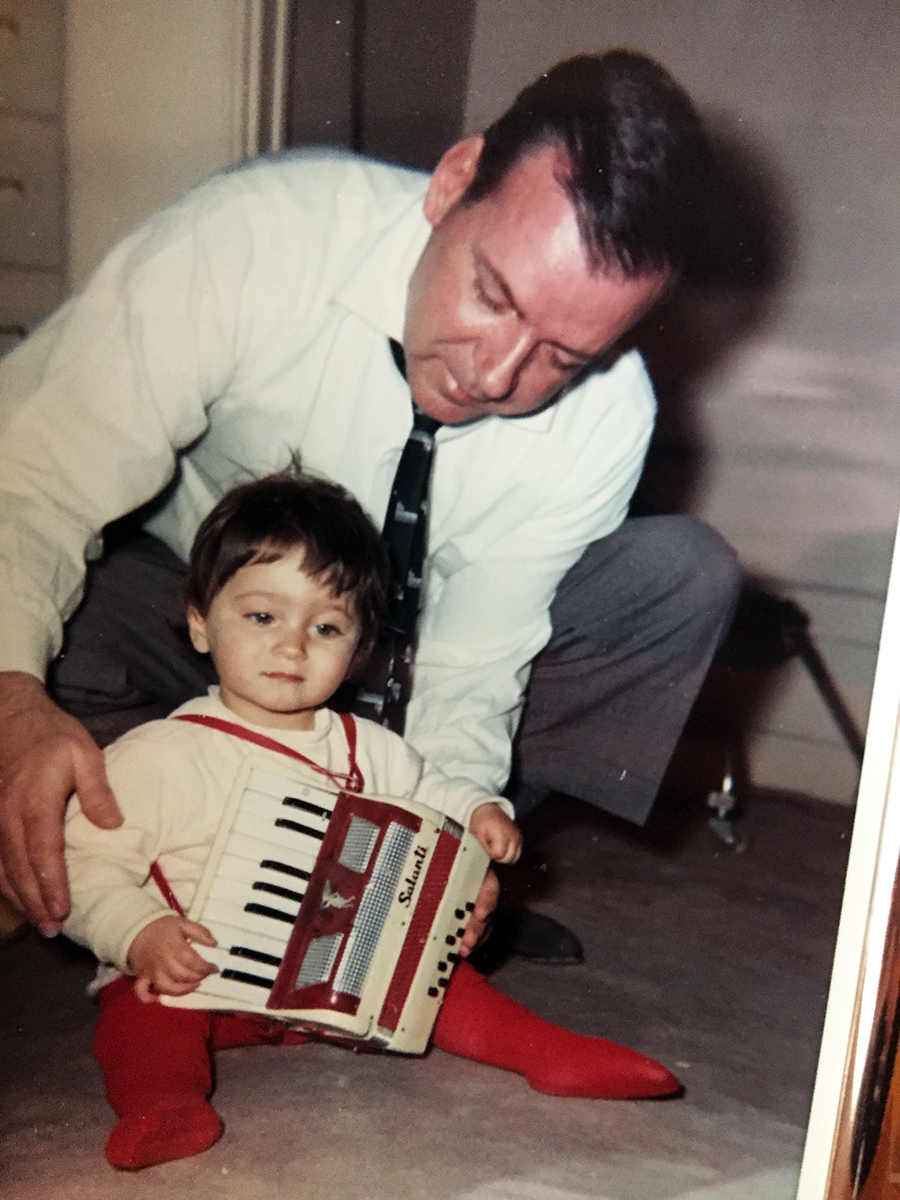
Little Lori with her dad.
“I grew up in Brighton Beach, Brooklyn, right at the foot of the boardwalk, and my dad was a big band trumpet player for about 30 years in New York City. There was a lot of jazz in the house all the time. My mom played accordion and she had a fantastic ear. She loved jazz and all the great jazz singers that we all know and love. I grew up hearing the great violinists Yasha and Michael Rabin, David Oistrakh, and Yehudi Menuhin. I grew up hearing classical music, opera, and jazz singers. My dad was always playing Miles and Charlie Parker and Coltrane and Wes Montgomery, so the house was constantly full of music.
“How we got to San Diego started when the big bands began to fizzle out. My dad was touring with one of the bands from New York in the wintertime with a lot of snow and bad weather, and they came out to lovely California. They came out to LA, to one of the big ballrooms on a beautiful Santa Ana day. My dad had been on the East Coast his whole life. The band did the gig in Los Angeles and then he and the trumpet section took a drive to San Diego; my dad just flipped, you know? He saw the blue skies and the palm trees and just said, ‘Yep, this is where I’m going to live someday.’ You know, this must have been in the late ’40s. He just found Paradise and that was it and life goes on. He marries my mom, I come along, and we moved out here when I was about 11.
“My dad just up one day and said, ‘That’s it, we’re moving to San Diego.’ My mom is a total Brooklynite, born and bred, very old school. She didn’t want to go, but we drove across the country, which took a month. We stopped at all the hotels. Anyway, we came into San Diego, and that’s how I got here.”
The flute wasn’t the first instrument she tried her luck on. She thought she might be a string player.
“I started on a four-string guitar in Brooklyn when I was four years old, and my dad taught me The Girl from Ipanema. And when we came out to California, I finally got a six-string guitar and was a very serious guitar player. I thought playing the guitar was going to be my thing forever. I was serious about playing jazz standards on the guitar and classical etudes as well. Everything I was doing was by ear on the guitar because I didn’t know how to read music at that point. I played from the age of four to 16 on guitar, 12 years playing strings, and then, suddenly, I came in contact with a flute.
“I went to visit one of my dad’s friends, Richard Swink, a clarinet player and a saxophone player. He’d just gotten back from a little road gig and picked up a flute at a pawnshop, and I was going over there to show him some of my original songs on the guitar. He whipped out the flute, and I said, ‘Hey, let me see that thing.’ Honestly, it was the weirdest thing, but I don’t know how I knew how to play it, but I had this instinct about it. Really, when I started playing it, I was able to just already play a song on it. It was like a revelation… he’s the one who took me through a method book so I could learn how to read. And then after three months of going through the book and practicing a lot, I started studying flute with Frederic Baker, who was the principal in the San Diego Symphony at the time. He was my very first flute teacher. I was taking lessons with him, but I was always playing along with the jazz records in the house, always using my ear and playing with records.”
As he she continued her diligence learning the flute, she acquired gigs and met other musicians who become mentors.
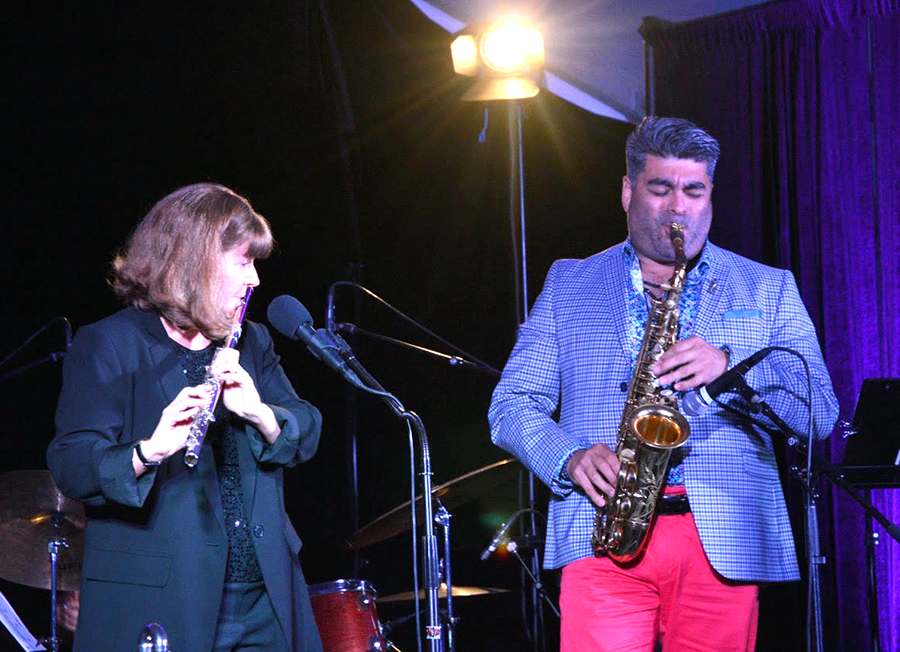
Lori with Charlie Arbelaez.
“I was fortunate to land a steady gig that lasted for nine years at a place called The Prophet, an international vegetarian restaurant. I got that gig about a year and a half after I started playing flute, and I also met Daniel Jackson, who really changed my life. I started playing his compositions and, oh, my God, just being around him and being around his music and his playing. And that’s how I also learned to play piano. He was the most amazing saxophonist, pianist, and composer. He was he was one of the cats, one of the major players in San Diego. An incredible musician and composer. He had a little orchestra that I played in when I was 18. Just having a chance to work with him. I played a lot of his original compositions at The Prophet… That’s kind of how I started in jazz, having a gig. I learned how to play piano by watching Daniel.”
Her piano skills improved to the point to where she was able to substitute for San Diego keyboard legend Mike Wofford when he couldn’t make his established gig at the University Club.
“Piano was like my second instrument. And I’ve had several steady gigs throughout my career, playing background for solo gigs and the last decade substituted for Mike Wofford. The gig was background dinner music gig. I mainly use piano as a tool for writing and composing and accompanying my students as well as subbing for pianist at gigs like the one Mike had at the University Club. I used to play up there all the time when Mike could not make it. The piano’s kind of a big deal. When I was around 25, Mike recorded one of my compositions on one of his solo albums, and that was my big claim to fame as a composer. Mike is one of my heroes.”
When she was 25 Bell met renowned pianist Dave Mackay, an event she calls one of her “biggest blessings.” The pianist took her under his wing, with older musician bringing her up to Los Angeles to play with his group. The experience with him brought her to the next level.
She says, “His musicality and the level of his musicianship… I mean, he helped me become an artist. From the first minute we played together, it was like I never sounded better. He just knew how to make you sound good. So, anyway, Dave Mackay was my hero and my mentor.”
She kept gigging through the weeks, months, and years, taking on new gigs, meeting other musicians, playing in different instrument combinations and styles. Each performance experience with her growing community of players enriched and broadened Bell’s already formidable ability as a jazz improvisor. A huge leap in her development as an artist was her time in the band called Lori Bell and the Italian Giants of Jazz, which featured pianist Joe Azarello and his brother, bassist Tom Azarello, with Tony Marillo (Joe Marillo’s brother) on drums.
“Joe and Tom were like my big brothers,” she recalls. “They’re both gone now. We just lost Tommy recently. Those guys were great. We all wrote together and played a lot of original music. Joe gave me one of his steady gigs.”
Then comes her meeting with a major musical partner, Ron Satterfield. She knew him as the pianist for Joe Marillo’s group, unaware that he was also a skilled guitarist. There was no initial spark between the two when they first met, but over time the pair became musically simpatico.
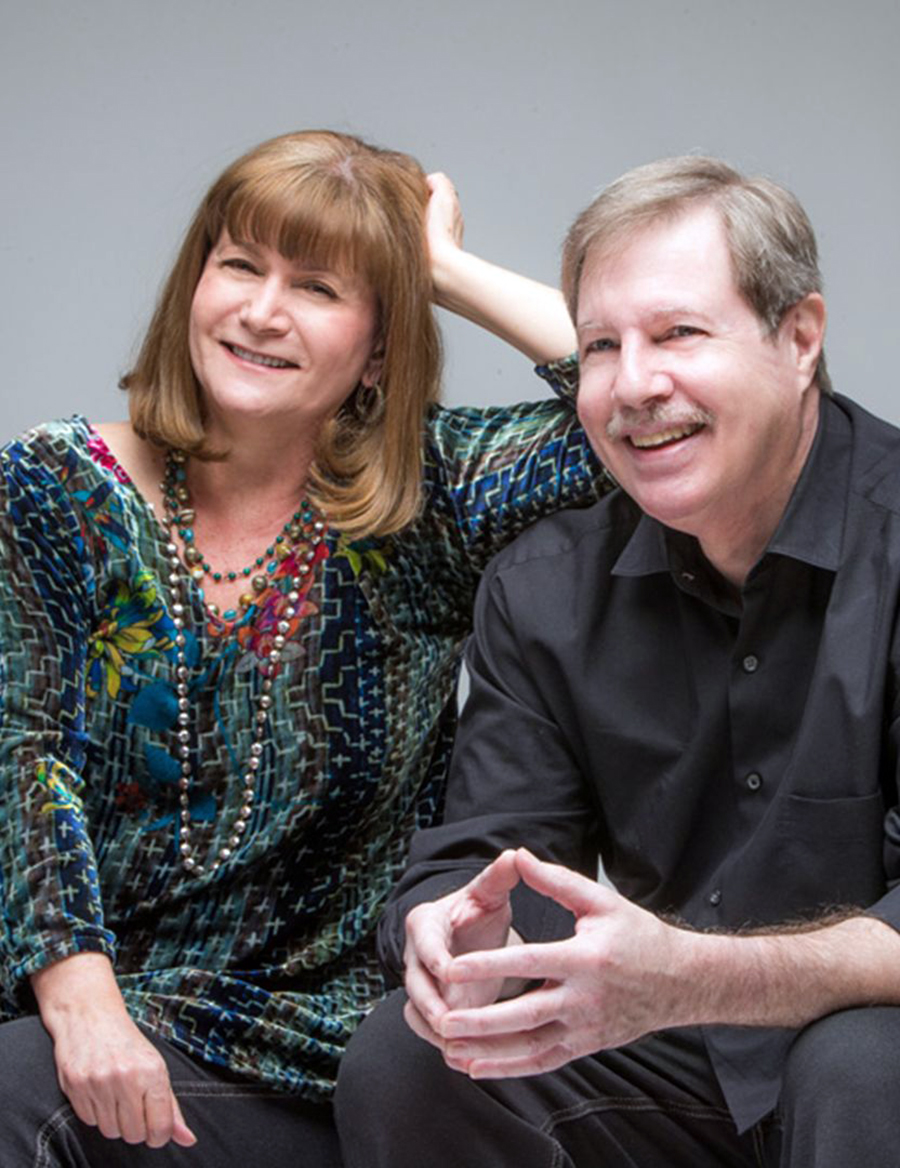
Lori and frequent collaborator Ron Satterfield.
“We just reconnected in a way neither of us expected. He found out that I could also play piano and compose, and he couldn’t believe it. A friend of mine brought one of my compositions for him to look at, and he asked me, ‘Who wrote this, who wrote these chord changes?’ I said I did. After that, I asked Ron if he could play standards on guitar? I had really no idea what he could do. At that time I had just picked up a solo gig every Sunday, and I asked if he wanted to play with me? I needed a guitar player. I had been working with a couple of other guitar players on a regular basis, but now I had Ron Satterfield on this gig, and suddenly it became mind blowing.”
Bell was so thrilled with the magic happening between herself and Satterfield that she called Dave Mackay. She was, of course, playing with Mackay at the time and was curious to see if the pianist could find a place for Satterfield in his band. Dave said yes, and they did the trio gig; from there we became a group called Interplay. After that gig, Dave would come to San Diego and rehearse, and then they’d go up to L.A. and perform with him. Dave is blind, so he would take the train down. They would rehearse all day.
“We had the Wizard of Oz medley, a Gershwin medley. We had so much original material. We made four albums together as Interplay. Thank God I have Ron in my life. Ron helps me with all my arrangements. The one thing that I will say about Ron is I think he has the biggest ears in the business. That guy can hear anything, and he can transcribe anything. We’re great friends and are real serious musical partners and have been for 25 years now. I feel fortunate that I have a musical partner who likes to get together and work out.”
As mentioned earlier, a remarkable aspect of Lori Bell isn’t only the generous virtuosity she bequeaths in her performances and recordings, but also that she is always working on something—a special project, a quality undertaking that allows productive outlets for her apparently unlimited energy. Her work enriches the cultural life in San Diego, both profound and moving. Collaborations abound, witnessed in her ongoing engagement with Trio de Janeiro with Satterfield and ace percussionist Tommy Aros. Other collaborations include ensemble work she’s contributed to in bringing the evocative and daunting compositions of Eric Dolphy and Joe Garrison to new audiences and old, dramatic reworkings of the songs of James Taylor and Joni Mitchell, and engagements in jazz centers around the country, most specifically Birdland, considered by many to be the preeminent jazz venue of our time. Let us say here that Bell isn’t one to sit on her hands. An especially large feather in her already well adorned creator’s hat is the jazz series she developed at the La Jolla Community Center. She is by now a significant and highly active part of the San Diego jazz community with a reputation that led to her contacted.
“About 11 years ago, I was called by Glenn Rasmussen, a board member at the La Jolla Community Center, a beautiful spot, who said that he wanted to start having jazz at the Center and he wanted me to run it. So, for two seasons, I went in there once a month, bringing different bands every time, different themes. I did All Women Jazz, I was bringing Mike Garson down from Los Angeles, I was trying to mix it up as best I could. And, of course, now you know the way it should be. There are different artists every month now, so I get to play once a year, and that’s great. It’s fun. I’m still happy that I’m involved in it and that I was able to start it and get it rolling. Now, Arlene Damasco books it and Nancy Walters from the Community Center keeps it going. I’m grateful to both of them. It’s a wonderful series, a beautiful space, and just a really cool event.”
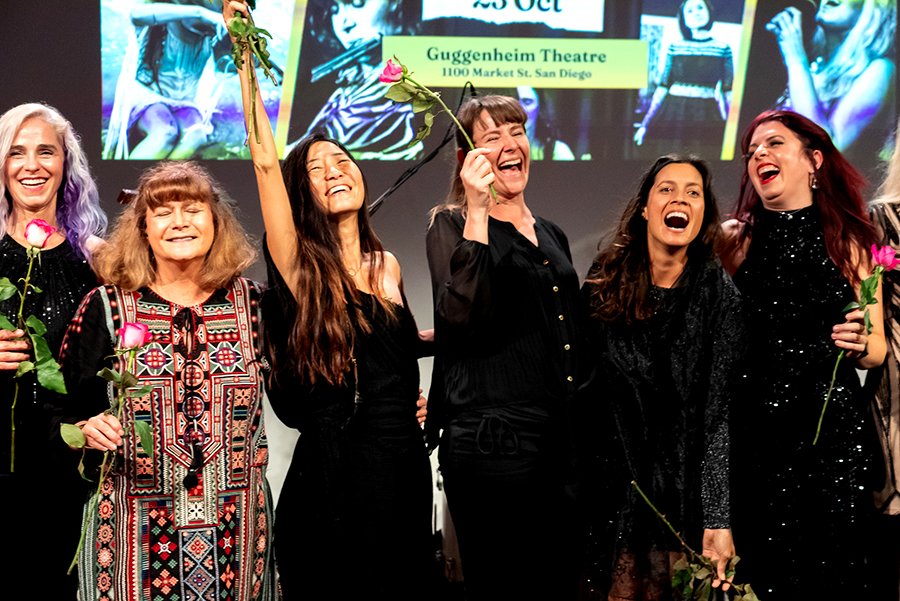
Women in Jazz concert in the Guggenheim Theatre, Park & Market building. Monette Marino, Lori, Jamie Shadowlight, Laurel Grinnell, Lorraine Theresa, Whitney Shay.
I was happy to oblige, because at that time things were a little bit slow, but that fell into my lap. I was like, oh, this is awesome. Now I get to write, arrange, and get all these different events, like different themes, right? Like music or Bill Evans or all spring tunes, things like that. Women in Jazz. Yeah, it was like this time it’s going to be Joe Henderson. We’re going to celebrate the album we’ve just made of his songs, Recorda Me: Remembering Joe Henderson.”
Recorda Me: Remembering Joe Henderson is her most recent CD, an inspiring , intense, and yet frolicking tribute to the late saxophonist’s compositions. On the recording she is accompanied by the simpatico trio of pianist Josh Nelson, bassist; David Robaire; and drummer Dan Schnelle. Nelson (who played with John Pizzarelli and Natalie Cole) is an ideal foil for Bell’s exuberant flow of ideas. They often intersect during the solo spots, producing witty dialogues based on Henderson’s subtle melodies. The album is a head turner.
She had it in mind to record an album dedicated to the work of another esteemed jazz musician and composer, so Bell had to decide which project she would do.
“I had it in mind to do a Bill Evans album, but that went on the back burner when I started to look more closely at Joe Henderson’s compositions. There are several other tunes I really like to play, like “Black Narcissus.” I watched more videos of Joe Henderson and listened to more of his music. Liking his music more and more kind of came in layers for me. I came across a YouTube video of Joe Henderson playing with an all-female rhythm section. This is in the ’80s or late ’70s, early ’80s. It was so foreign to me, I almost didn’t believe it was true. I was almost like, where are you ever going to see a prominent saxophone player of his era playing with the all-female rhythm section? Never, never, never. Who does that? My first thought was, oh, they must have talked him into doing this. But then I found that no, he did an entire live album with them under his name, a record called Punjab, with an all-female section. I was like, I love this man.
“This is before it became fashionable to have a woman on the bandstand. That happened more in the late ’90s, early 2000. You started seeing Kenny Barron, featuring women instrumentalists, not singers. It really got me more interested in him. What a cool guy, man. No weird trips about playing with women, you know? And then I started working on this arrangement, which I mentioned in my liner notes on the record Serenity. I started working on the piano on that tune and as soon as I found my six Afro grooves, I was off and running. And that’s when I could really see a project starting to develop.
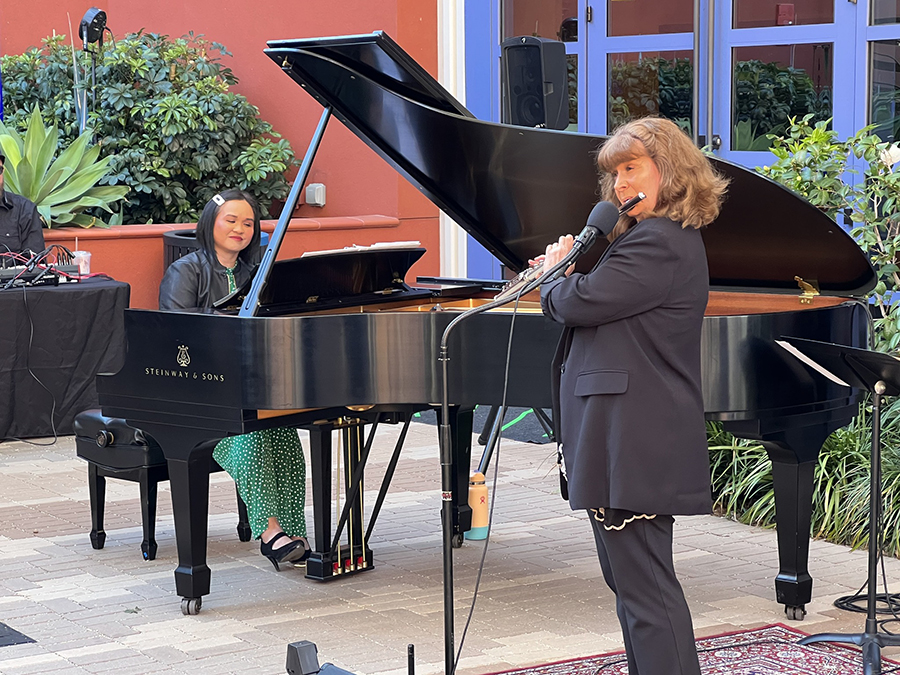
Lori and Melonie Grinnell.
Making note that the flute is an unusual instrument to highlight in a tribute for an acclaimed saxophonist and composer, Bell realized she needed to work in earnest to interpret the songs in ways that were different, distinct, and yet retained the spirit and nuance of the source material.
“I must do something different with this because I don’t want to record it the way everybody plays it. The first thing I really had to do was find the key that’s was going to lay on the flute the best. So, a lot of his tunes on the record are in different keys, oftentimes like different groups that may have a long introduction area. And then I have somewhat of a rhythm on the melody. Then we have the melody, and we have different chords for the drum solo and different figures for that. And, and then I have a unique ending for it. So, I put a lot of time into all these arrangements, and I started thinking that this might be a project.”
She gives high praise to the musicians who were essential in making this a flawless gem of a record and also gives the highest credit to her co-lead soloist Josh Nelson on piano for making the ideas burn so bright and lovely.
“I knew Josh was the guy for this,” says Bell. “There was no doubt about it. The guys all thought that we were going to have a rehearsal before the session. I didn’t want to rehearse it too much. I want to just do it. I brought all the charts and said let’s just look at stuff in the studio and go for it. I wanted it to try to be as spontaneous as possible, and I also wanted to see what their input might be. So, we didn’t rehearse. We just kind of huddled around the piano and looked at the chart and just went for it.”
The troupe went for it indeed and recorded a work that is a masterful, luminescent reimagining of a jazz master’s music. Critics have responded in kind, praising the album with a chorus of superlatives. The Troubadour’s review said, “… This music moves fast on the uptake, is light on its feet, and is memorable and compelling, rendered with a fervent wholeheartedness by a superlative ensemble.
JazzWeekly.com’s George Harris wrote, “… Bell brings a lightness to the usual dark tones of Henderson, making his songbook fresh and fragrant, with a hip read of ‘Isotope’ and a glowingly warm ‘A Shade of Jade.’ Nelson keeps ‘Black Narcissus’ impressionistic and ‘Out of the Night’ verdant, with Schnelle driving along in third gear on a cruising ‘Inner Urge.’”
The reviewer for MakingaScene.com enthused, “… She dives and dips across space, with Nelson often following her lead and repeating Bell’s creative melodic phrases on piano. While playing the composition ‘A Shade of Jade,’ both instruments sound like birds playfully cruising across the sky.”
LAJazzScene.buzz states writes, “… Joined by pianist Josh Nelson, bassist David Robaire, and drummer Dan Schnelle, Lori Bell is heard at the peak of her powers. She takes high-quality solos on all of the pieces, some of which have tricky melody lines or complex chord changes. Highlights include such numbers as ‘Isotope,’ ‘A Shade of Jade,’ ‘Black Narcissus, and ‘Punjab’… Ms. Bell certainly makes the case for recognizing Joe Henderson as a major songwriter.”
This month Bell has two significant performances scheduled.
The first is part of the Jazz Live series at the Saville Theater on the San Diego City College Campus, hosted by KSDS Jazz 88.3, featuring the Lori Bell Quartet with virtuoso pianist Tamir Hendelman, Mackenzie Leighton (bass), and Kevin Koch (drums). Tuesday, June 18 at 7:30pm. The Saville Theater is at 1341 C Street. Go to https www.jazz88.org/jazz-live/ for ticket information, directions, and parking instructions.
On Friday, June 28, at 7pm Bell returns to the La Jolla Community Center for a special performance of Recorda Me: Remembering Joe Henderson for their acclaimed Fourth Friday Jazz Series. With the flutist will be Tamir Hendelman on piano and the esteemed Ron Satterfield on guitar and vocals. The La Jolla Community Center is located at 6811 La Jolla Blvd, La Jolla. For ticket information, go to www.ljcommunitycenter.org/special-events. (8.
Many who’ve seen Lori Bell perform live over the years or those who’ve had the pleasure of talking to her about life, music, the sheer joy of being able to thrive doing something you love, and emphatically bringing that exuberance to audiences become quickly aware of the musician’s gratitude for the life she knows, performing the music she loves. “From Bach to Bebop” is a phrase that pops up in her press materials, and it’s not a glib declaration. Her range, from classical, bop, and Miles to the daunting charts of Dolphy, one witnesses Bell digging deep into the repertoires, investigating possibilities in the scripted notes, lovingly bringing new and unexpected verve and fresh passion to the music that inspires. A musician as ebullient as she is brilliant, it’s impossible not to be impressed with her contagious spirit; she speaks soaringly of her influences, her mentors, her partners in music making, and she expresses a conspicuous gratitude. She remains curious about what phrase, riff, or what melodic grouping will be inspired by the music she lays out in front of her. Bell remains intrigued by the possibilities of making the music fresh and newly timeless. And she will have the delightful problem of what project to take on next.


